Are you considering learning some basic homesteading skills? Maybe adding a few chickens to your backyard? Or moving further into the homesteading life by adding different animals? Have you considered these animals will poop?
Perhaps you already have a variety of animals and are experiencing issues. Here are a few lessons that we learned the hard way! With our noses.
We raised ducks, chickens, and rabbits in our backyard homestead. Each brought their own unique challenges!
Poop
Let’s start with the fact all poop is not created equal.
Ducks
Water! Duck poop has an extremely high water content and it can very quickly become a management issue. If raising ducklings in a brooder, add their wet poop to the fact that they love to get their drinking water everywhere and you’re in for some real fun!
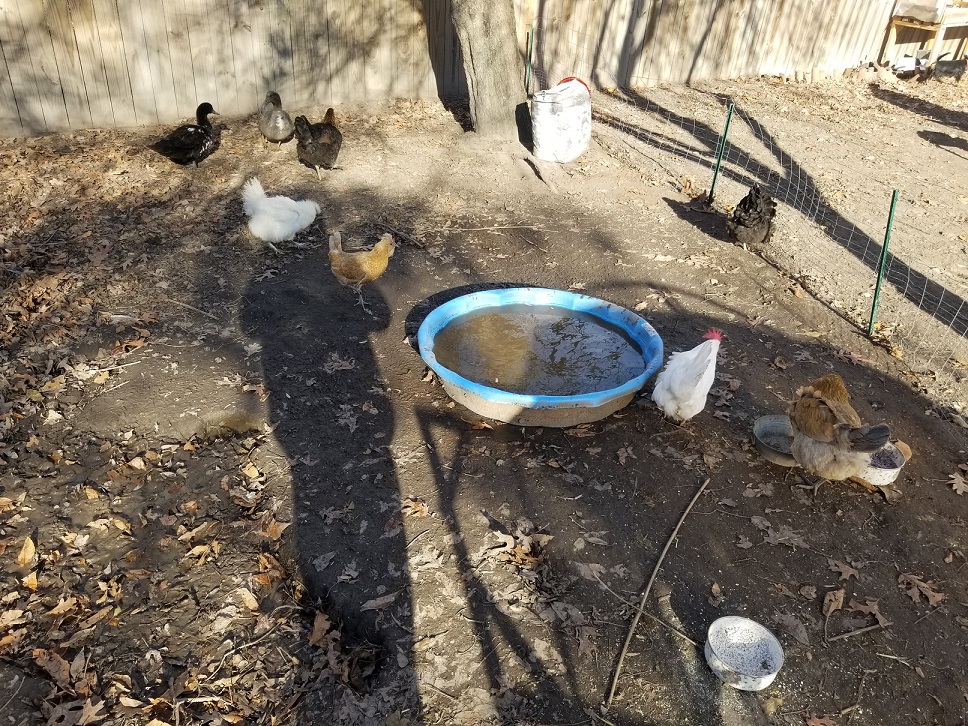
The two large challenges were: the build up in common areas and the duck pool. A duck pool will quickly get a sludgy poop mess at the bottom- within a day! That is then dumped out into the yard where you still have a sludgy mess of poop…
The sludgy mess is a very nutrient dense mess! Though I never found a real good way to get it towards any plants without also becoming a mess!
If the ducks always bed down in the same spot, expect the bedding in that area to be saturated with poop. Also, there will be poop in a circle around your feeder and water. About the length of a duck from where they stick their heads to eat or drink!
Our ducks now mostly stay outside in a large fenced run which eliminates some of the management challenges in the coop. We do have a few broody ducks that have a bedding poop cake around the nest…and we can’t get near it!
Chickens
Nitrogen! Chicken poop has a high nitrogen content which can be harmful to plants. There is some breakdown that occurs as the poop ages and can give off an ammonia gas, generally noticeable in the coop. Good management and adequate ventilation in the coop is key!
Chicken poop retains its shape, looks more like normal bird poop, vice a brown puddle that ducks have. The health of a chicken can often be determined by the poop. Again, not all poop is created equal! I recommend having a chicken health book or google available if you notice a poop that looks different.
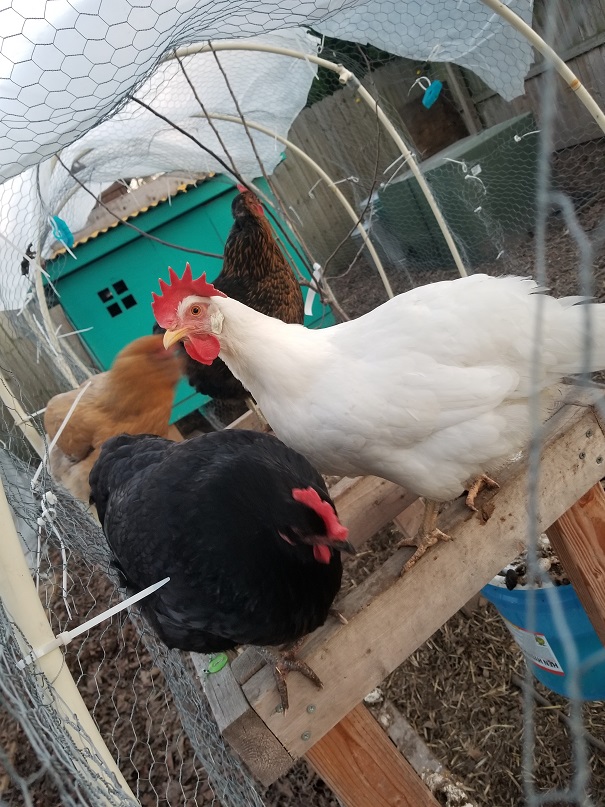
Rabbits!
Little brown nuggets of garden gold! Rabbits release little pellets that are generally simple to shovel up and spread out into your garden or yard. If the pellets are not peed on or exposed to rain they will generally dry out and be easy to move. When rained on (or under a leaking waterer) they will start to become an issue!
Since we raised our rabbits off the ground in cages we had all the poop located in one spot. If you have your rabbits in a larger area I would think the management is similar to large poultry runs.
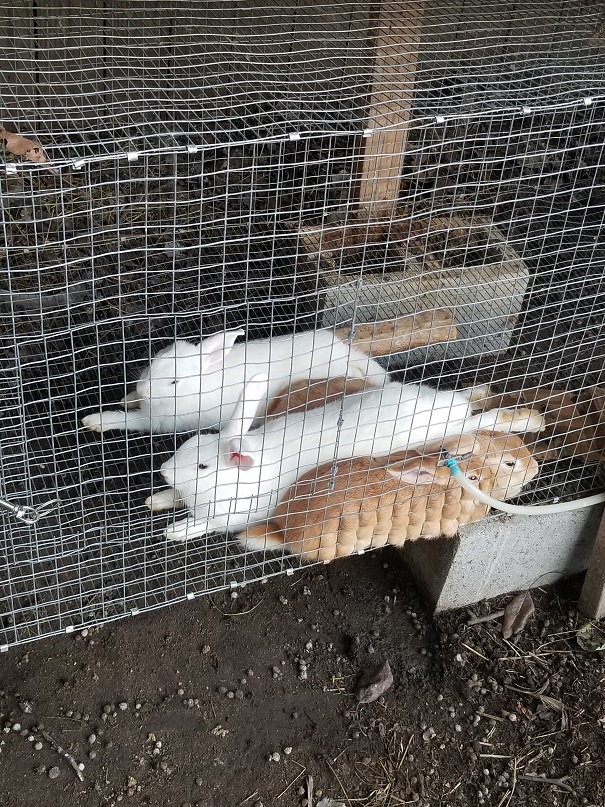
Poultry Poop Management
In composting you need a balance of green material to carbon. The management of poop is the exact same! Poop is green material and must be balanced with carbon. Now the random poop out in the yard is fine, but the concentrated areas i.e. runs, coops, under cages, and near the feed station all have the potential of creating a grand stink.
To balance the equation, add lots of hay or pine shavings (aka carbon!). If you can smell poop then your balance is off and you need more hay or pine shavings! There are recommendations out there for various ratios required to have good composting mix or management.
I struggle with the ratio approach because hay and chicken poop are not even close to the same shape. “X amount of carbon to Y amount of poop” doesn’t help me at all (and I actually enjoy math). I err on the side of caution and add more than I think will be needed. When all else fails, I let my nose decide! After a few years of practice, my nose has told me less often that we were out of balance.
Coop
Balancing the poop to carbon is relatively easy in the coop. For chickens, the area under any roosting bars will likely need more additions. Ducks will need more carbon material near the spots they sleep on the ground. We found benefit in mixing the poop and hay around in our coop to work in some of the less used areas and stretch time between total change outs.
Most birds will avoid pooping in the nest boxes. Although we had the occasional hen that would not get the hint and then we would have to watch the boxes (especially if you are blindly putting your hand in there)!
Duck poop makes more of a hay poop patty cake in their nesting areas. Breaking it up and mixing more hay or pine shavings in will give a better poop to carbon ratio preventing or removing any smell. If the duck is broody then it is hard to address the poop around the nest. Really I just avoid getting near the nest because I have been bitten before.
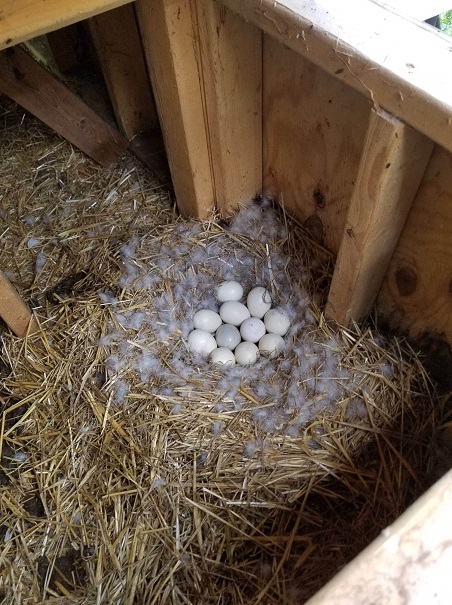
*We recommend a rake or a hoe for mixing the bedding inside a coop. Doing so by hand would not be pleasant*
The winter presents a slight management idea shift. We generally go the entire winter without changing the bedding, an attempt at the deep bed method. The idea is a large layer of bedding mixed with the poop and continuing to be layered on through the cold months will start to compost and generate heat. I am not sure if our attempts at this were effective since our coop was smaller and hard to access. Honestly, the chickens would sometimes roost outside while the ducks were sleeping on the snow…
In spring that massive amount of hay and poop would be taken out and fresh bedding applied. During the warmer months we would change the bedding more frequently. We applied the fresh bedding to the coop and used the old bedding outside on the ground!
Frequented areas
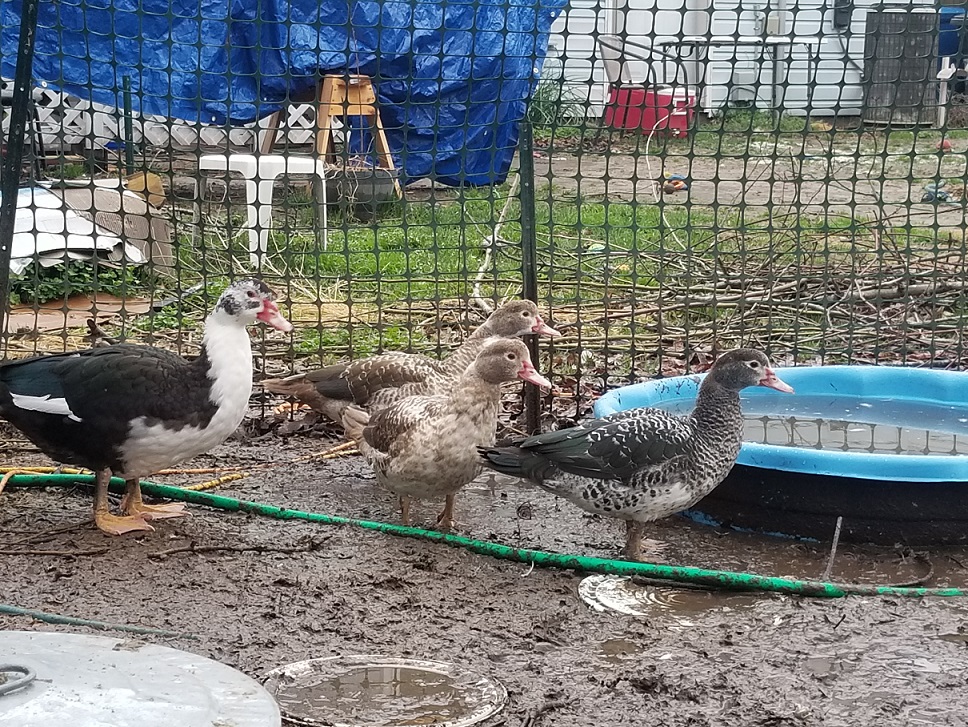
Wherever your birds spend the day! Attached run, puddles, pool, food and water, and in the past our porch! Learn more about free ranging challenges in a backyard here!
Remember how we pulled the bedding out of the coop?
Instead of using fresh hay in these frequented areas, we would shovel and rake the already used bedding to cover these spots. If we had a heavy rain we would have to augment our general practice and use fresh hay or pine shavings. (Hay was not added to the porch, a pressure washer worked well there).
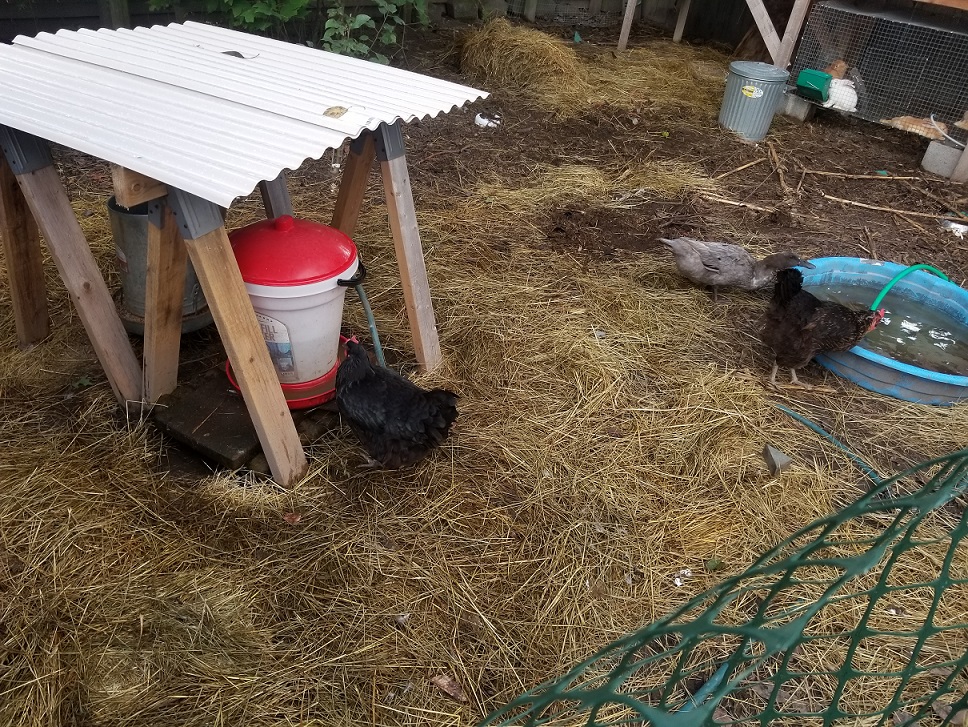
Hay in rain gets heavy and soggy, though if you have a large amount it can be like walking on a sponge. It would generally get a musty sort of smell, especially when we used an attached run model and had not put a tarp cover over the top.
If you get a poop-like smell, add more hay or wood shavings!
Rabbit poop management
So much could be covered with rabbit poop. There are 3 main areas we struggled: rabbit poop and water (or pee), solid floor hutches, and nesting boxes.
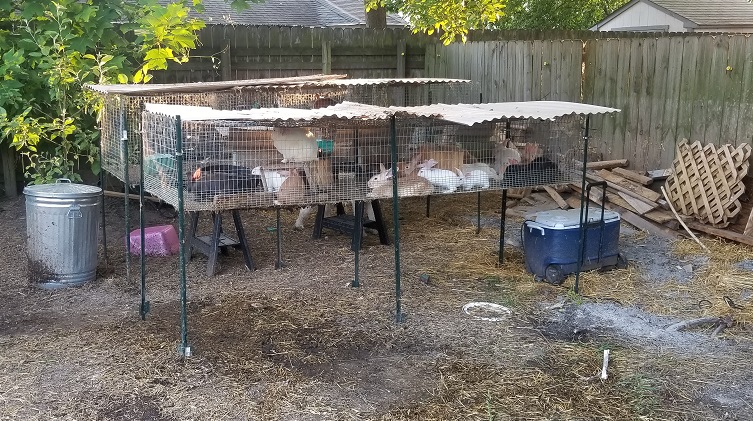
In general, rabbit poop falling directly to the ground will start to dry out. We also would get weird white and pink mold build up at times, but just spread it out in our backyard. I liked to use pine shavings under the runs in layers. The goal was to make the layer of pine shavings as thick as the layer of poop. A 50/50 ratio if you will. Was this always the case? No, I could have done a much better job of keeping pine shavings and hay on hand! If we were off, the nose check would always tattle on you!
In our final year we switched to cedar shavings because they smelled nicer and our muscovy ducks generally left them alone. They did enjoy eating the bugs under the cages and we were thankful for that!
Rabbit poop and water
Before our wonderful system above, we had a more condensed double stacked cage system. I built the system with a poop chute under the top cage as recommended in a design I saw or read about. This would have been great if the poop would actually roll down. Instead it would get stuck and we would have to spray it out which would add more water into the poop. Our levels of hay and pine shavings used in this system were crazy high and still got us a neighbor complaint.

*There are designs for having two cages stacked. Ensure you leave enough room to push/scrap the poop out. I failed at this. Additionally, catching the poop in a wheel barrel for further composting in a different pile would be beneficial if you have the room.*
I was working an automatic watering system to reduce chores. Unfortunately the initial water system would leak, adding even more water to the mix. The section under the waterers (which is generally already a more damp area) was becoming poop sludge. Almost on par with the duck pool, but the pool did not stink like this!
The only management tool for poop- more carbon! In my case a better system was in order and much needed! (Future post on this)
The area under the bottom cage was only off the ground by cinder blocks. It would frequently need to be cleaned out because there was no easy way to mix hay or pine shavings into it. Any rain runoff from the roof or spray off the poop chute would drain back into the area under the bottom cage causing problems.
**Cinder blocks for supports: When the flat side was used to support the cages the poop would build up inside the cage and was hard to spray out. So the smart thing to do is switch them right? Then the poop goes into the holes which would mix with pee and also become an issue. Smell would shortly follow and would be difficult to get out! Both options had challenges and why I would not recommend this system**
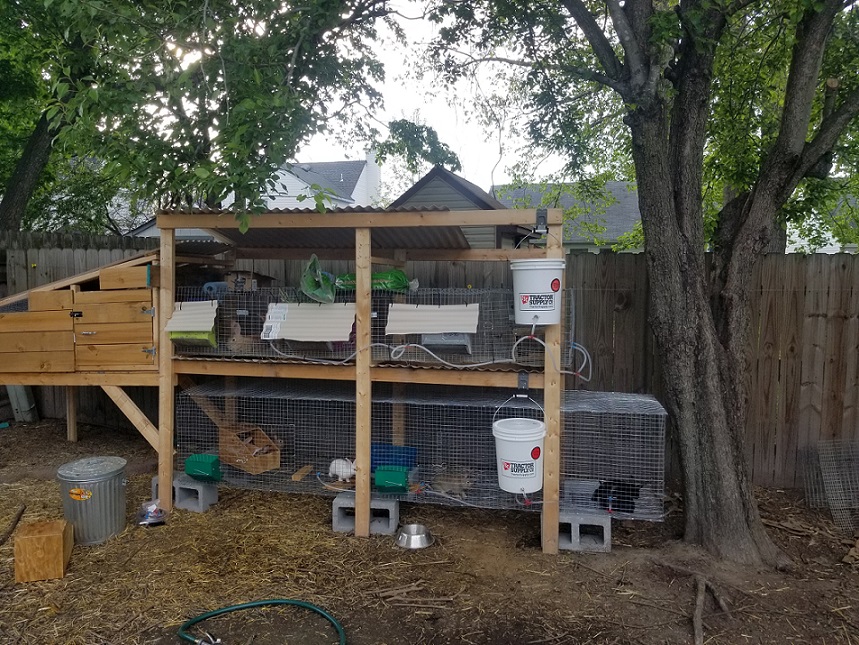
Inside the solid floor hutch
Our first model for rabbit cages included an attached hutch with a wooden floor. Another idea I do not recommend. I filled it with hay similar to the nesting boxes. This quickly became a mess from the rabbits’ poop and pee. The poop and water mix smells bad, but the poop and pee mix can make you gag. I changed this to a wire floor but still tried to keep some hay in it. The hay fell through the cracks, so we added some flat boards with gaps. Bad idea… back to square one. I eventually tore apart this whole system due to the challenges we faced!
The Nesting Box
Nesting boxes for rabbits also carry a potential for localized stink. We used a community model of raising the rabbits which also meant the nesting boxes were always available. I would frequently have to change out the hay in these boxes due to the poop and pee build up inside.
It was seldom one of our does that was causing the problems. Generally, the rabbits close to butcher weight were using the boxes as a bathroom. Also, if they are located in an area not covered you will get rainfall inside the box compounding the issues.

Flies
No matter where the poop came from, there will be flies! The challenge is a balance. With the run, we found the fly load to become really high, larger than what the birds were actually eating. Once we added rabbits, the chickens and ducks were critical in managing the fly population. We removed the run and sectioned off part of the yard for the birds to have. This provided a balance in our management that was amazing.

After a predator attack wiped out most of our flock, the fly population swelled around the rabbit cages to the point where we dealt with fly strike. Fly strike is when the flies lay their larva in the hind area of the rabbit and the larva actually comes out of a wound they create on the rabbit. It was horrible to deal with and another reason why good management is key. Hopefully you can learn from our challenges.
Handling manure
Avoid shoveling when the manure is wet. Our jobs and free time dictated having to do this many times which was horrible. Particularly with the rabbit manure where I was struggling to get a good balance of carbon to poop. A trusty wheelbarrow is a must have for this job!
Composting, manure, and gardens
An aspect of homesteading we love is how so many things compliment each other. Scraps from the garden go to the chickens, ducks, and rabbits. They turn this into poop which then goes back to nutrients for the garden for the cycle to continue. I will lightly touch on the compost topic here. (Lightly because whole books have been written)
I have not attempted a hot compost pile yet so cannot speak to it. My understanding is the balance between carbon and green material must be right with moisture to reach higher temperatures. The compost action occurs much faster than a year long decay cold method we use but also requires more attention.
Attention is time, and time is in short supply with both of us working full time with two young boys! So we will stick with the little to no attention cold method for now! Learn more about who we are here.
A cold pile will break down into a dirt like hummus over the course of a year or more. If you balance your poop to carbon ratio like I do then just transfer your pile and leave it! The challenge being whatever you add on top will still need time to compost (using a new pile or bin each year in a 3 year rotation is a great practice I intend to try).
We used a plastic compost barrel with a bottom access to pull out that lower rich hummus layer! It worked decently but really did not have the capacity for how much compostable material we had!
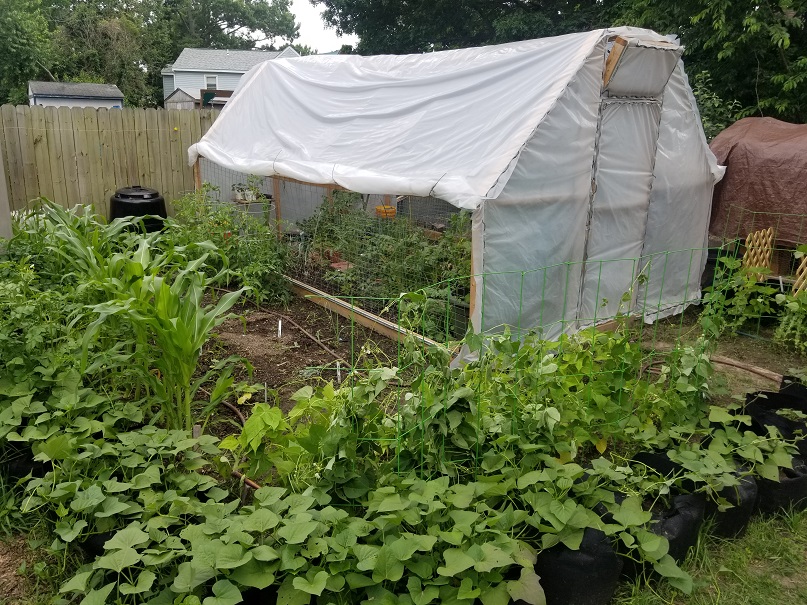
So what if you don’t wait a year….which I admittedly was often impatient.
The idea of crumbly well composted manure to grow veggies in is awesome. The idea of growing veggies in fresh poop…not awesome. I would apply somewhat composted manure in the spring, and potentially much fresher stuff in the fall when not growing a winter garden. We never added fresh manure to areas growing root crops or salad greens that season. For these areas we composted food scraps inside our garage using worms!
Our birds had some limited access to the garden, which meant they would fertilize during the year while scratching through the garden. Chickens do still have the concern with high ammonia, but their poop will be spread out all over. Ducks are safer for plants, as long as the plants are big enough to not be trampled!
We briefly mentioned pathogens earlier; keep chickens and ducks away from the root and salad crops. Outside of our potatoes buried in pots all the root and salad crops were located inside the hoop house (unheated greenhouse). The birds would often help eat bugs off any squash, tomato, pepper, corn or bean plants growing. What they could not do was poop on any of the leafy greens we would use for our salads and therefore no salmonella concern in our lettuce!
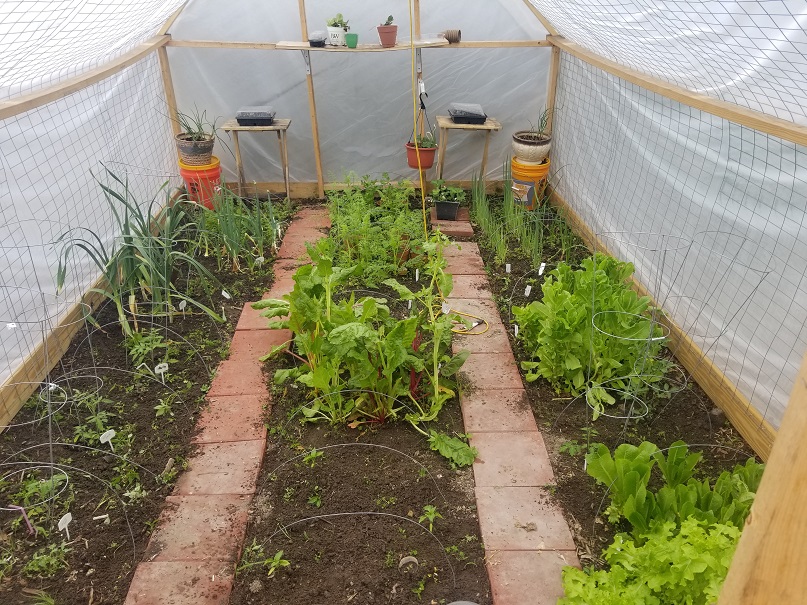
Hopefully you have found our experience in poop management helpful! I admittedly did not consider poop enough when we added animals to our urban homestead. I knew I wanted the manure for improving soil health, and that was about all! Boy did we learn.
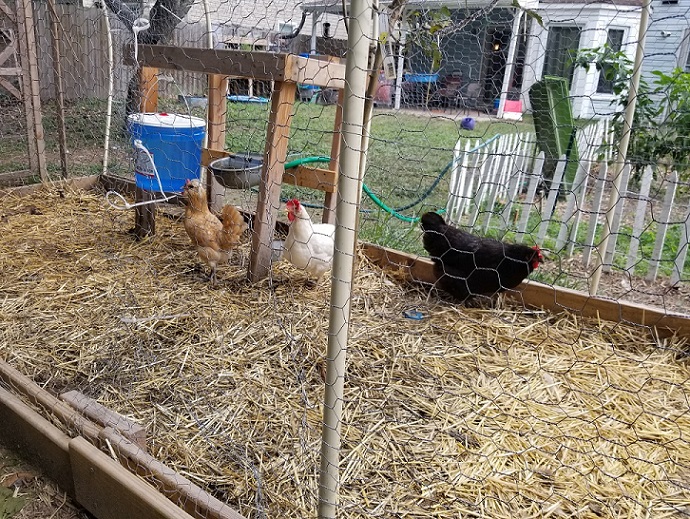
Those veggies look amazing!